Scarring is typical with moderate to sever acne and there are acne scar creams that work great and can eliminate the appearance of scarring completely. Click HERE
Mild to Moderate Acne Vulgaris consists of the following types of acne:
|
Whiteheads
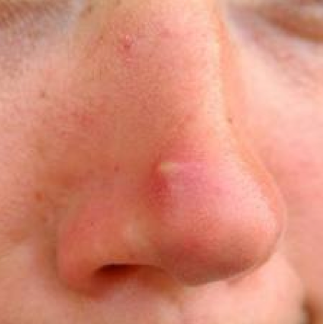 Whiteheads form when a pore is completely blocked, entrapping sebum (oil), bacteria and dead skin cells. Since the air is unable to reach the follicle it causes a white appearance on the surface. Whiteheads are normally dissipated within a shorter life cycle than blackheads. Whiteheads form when a pore is completely blocked, entrapping sebum (oil), bacteria and dead skin cells. Since the air is unable to reach the follicle it causes a white appearance on the surface. Whiteheads are normally dissipated within a shorter life cycle than blackheads.
Make Whiteheads disappear with the Acnezine Acne Treatment.
|
Blackheads
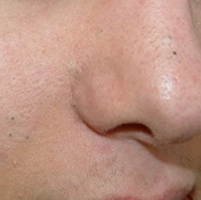 Blackheads result when a pore is only partially blocked, allowing some of the trapped sebum (oil) and dead skin cells to gradually make its way to the surface. However the black color is not caused by dirt. More or less it’s the skin’s own pigment, the melanin, interacting with the oxygen in the air. Blackheads are much more stable structures, allowing them to take much longer time to clear than whiteheads. Blackheads result when a pore is only partially blocked, allowing some of the trapped sebum (oil) and dead skin cells to gradually make its way to the surface. However the black color is not caused by dirt. More or less it’s the skin’s own pigment, the melanin, interacting with the oxygen in the air. Blackheads are much more stable structures, allowing them to take much longer time to clear than whiteheads.
Make Blackheads disappear with the Acnezine Acne Treatment.
|
|
|
|
|
|
If you have one of these four types of Acne it is very likely you will be able to clear it up!
 |
Severe Acne Vulgaris
Severe Acne Vulgaris is characterized by nodules and cysts: |
Nodules
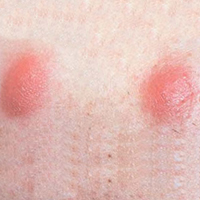 As unlike the information on lesions noted above, nodular acne is spots of acne which can be much larger, quite painful and can last for several months. Nodules are large, hard bumps under the skin’s surface and scarring is quite common with this type of acne. Untreated nodules can sometimes leave an impaction behind, allowing it to flare time and time again. The worst thing you can do if this occurs is to squeeze it. You most likely will cause severe damage to the skin as the lesion may last for months longer than it normally should. It is recommended that treatment be sought from a dermatologist where they can administer a shot of cortisone to reduce any inflammation as well as the chance of scarring. As unlike the information on lesions noted above, nodular acne is spots of acne which can be much larger, quite painful and can last for several months. Nodules are large, hard bumps under the skin’s surface and scarring is quite common with this type of acne. Untreated nodules can sometimes leave an impaction behind, allowing it to flare time and time again. The worst thing you can do if this occurs is to squeeze it. You most likely will cause severe damage to the skin as the lesion may last for months longer than it normally should. It is recommended that treatment be sought from a dermatologist where they can administer a shot of cortisone to reduce any inflammation as well as the chance of scarring.
|
Cysts
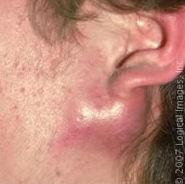 An acne cyst appears almost similar to a nodule but is pus-filled, and is explained as having a diameter of 5mm or more across. Again they are quite painful and scarring is commonly known to happen with cystic acne. Squeezing an acne cyst will only worsen the situation and cause the infection to spread as it deepens; more painful inflammation which will last much longer than if you had left it alone. Dermatologists usually have ways to reduce swelling and take preventative measures to reduce the chances of scarring scarring, such as administering a cortisone shot. An acne cyst appears almost similar to a nodule but is pus-filled, and is explained as having a diameter of 5mm or more across. Again they are quite painful and scarring is commonly known to happen with cystic acne. Squeezing an acne cyst will only worsen the situation and cause the infection to spread as it deepens; more painful inflammation which will last much longer than if you had left it alone. Dermatologists usually have ways to reduce swelling and take preventative measures to reduce the chances of scarring scarring, such as administering a cortisone shot.
|
Acne Rosacea
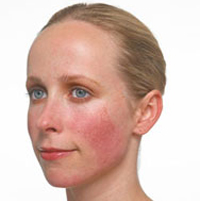 is commonly mistaken for Acne Vulgaris do to the similarity in features. Rosacea appears in the form of a reddish rash and is usually limited to the chin, cheeks, nose and forehead and it affects millions. Rosacea typically affects those who are over the age of 30. The redness is often accompanied by bumps, pimples and skin blemishes. In some cases vessels of blood become more visible through the skin. Rosacea and blackheads are not likely to be found on the same person. It more commonly found in females yet often more severe when found in males. This condition left untreated could cause swelling of the nose along with excessive growth tissue, a condition called Rhinophyma. The treatment for Rosacea is usually different than for acne, Therefore if you suspect your experiencing this condition, contact your dermatologist right away. is commonly mistaken for Acne Vulgaris do to the similarity in features. Rosacea appears in the form of a reddish rash and is usually limited to the chin, cheeks, nose and forehead and it affects millions. Rosacea typically affects those who are over the age of 30. The redness is often accompanied by bumps, pimples and skin blemishes. In some cases vessels of blood become more visible through the skin. Rosacea and blackheads are not likely to be found on the same person. It more commonly found in females yet often more severe when found in males. This condition left untreated could cause swelling of the nose along with excessive growth tissue, a condition called Rhinophyma. The treatment for Rosacea is usually different than for acne, Therefore if you suspect your experiencing this condition, contact your dermatologist right away.
There is no current cure for Rosacea but there are a treatments for Rosacea that are effective and will help you a lot.
|
Severe forms of acne
Severe forms of acne are rare, but inflict such hardship on those people who experience them. In all cases doctors are most likely going to prescribe Isotretinoin (Accutane).
|
Acne Conglobata
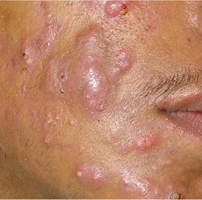 The most severe type of Acne Vulgaris and is most commonly found in males. It is characterized by numerous large lesions, which are sometimes interconnected, along with widespread blackheads. It can cause severe, irreversible damage to the skin, and disfiguring scarring. This unfortunate type of acne is found from your thighs up “Thighs, buttocks back, chest and face.” Acne Conglobata can show up as early as 18 and usually no later than 30, however this condition can stay active for several years after. As with all forms of acne, the cause of Acne Conglobata is unknown. Treatment usually includes Isotretinoin (Accutane), and although Acne Conglobata is sometimes resistant to treatment, it can often be controlled through aggressive treatment over time. The most severe type of Acne Vulgaris and is most commonly found in males. It is characterized by numerous large lesions, which are sometimes interconnected, along with widespread blackheads. It can cause severe, irreversible damage to the skin, and disfiguring scarring. This unfortunate type of acne is found from your thighs up “Thighs, buttocks back, chest and face.” Acne Conglobata can show up as early as 18 and usually no later than 30, however this condition can stay active for several years after. As with all forms of acne, the cause of Acne Conglobata is unknown. Treatment usually includes Isotretinoin (Accutane), and although Acne Conglobata is sometimes resistant to treatment, it can often be controlled through aggressive treatment over time.
|
Gram-Negative Folliculitis
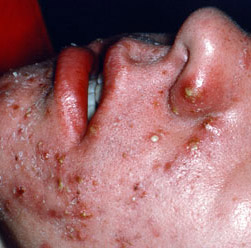 This condition is a bacterial infection characterized by pustules and cysts, possibly occurring as a complication resulting from a long term antibiotic treatment of Acne Vulgaris. It is a rare condition, and we do not know if it is more common in males or females at this time. Fortunately, Isotretinoin (Accutane) is often effective in combating Gram-Negative Folliculitis. This is technically not a form of acne but mimics the look of acne. This condition is a bacterial infection characterized by pustules and cysts, possibly occurring as a complication resulting from a long term antibiotic treatment of Acne Vulgaris. It is a rare condition, and we do not know if it is more common in males or females at this time. Fortunately, Isotretinoin (Accutane) is often effective in combating Gram-Negative Folliculitis. This is technically not a form of acne but mimics the look of acne.
|
Pyoderma Faciale (Rosacea Fulminans)
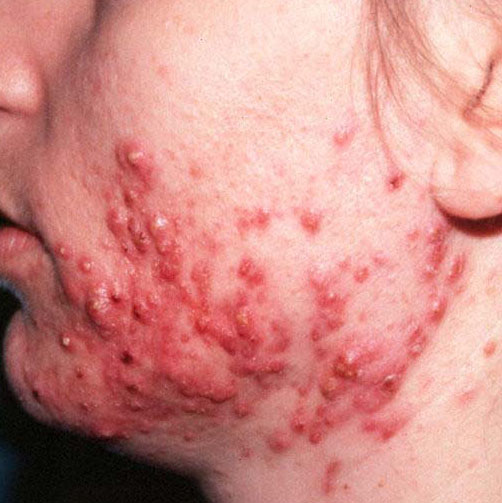 This type of severe facial acne affects only females, usually between the ages of 20 to 40 years old, and is characterized by large painful nodules, pustules and sores, all of which may scar. It begins abruptly, and may occur on the skin of a woman who has never had acne before. It is confined to the face, and usually does not last longer than one year, but can wreak havoc in a very short time. Doctors often prescribe Isotretinoin (Accutane) and systemic corticosteroids. This type of severe facial acne affects only females, usually between the ages of 20 to 40 years old, and is characterized by large painful nodules, pustules and sores, all of which may scar. It begins abruptly, and may occur on the skin of a woman who has never had acne before. It is confined to the face, and usually does not last longer than one year, but can wreak havoc in a very short time. Doctors often prescribe Isotretinoin (Accutane) and systemic corticosteroids.
|
| Try Isotretinoin (Accutane) From BM Pharmacy |
You can see how important it is to know what types of pimples there are so you can be diagnosed accurately and then proceed with the proper treatment.
 Whiteheads form when a pore is completely blocked, entrapping sebum (oil), bacteria and dead skin cells. Since the air is unable to reach the follicle it causes a white appearance on the surface. Whiteheads are normally dissipated within a shorter life cycle than blackheads.
Whiteheads form when a pore is completely blocked, entrapping sebum (oil), bacteria and dead skin cells. Since the air is unable to reach the follicle it causes a white appearance on the surface. Whiteheads are normally dissipated within a shorter life cycle than blackheads. Blackheads result when a pore is only partially blocked, allowing some of the trapped sebum (oil) and dead skin cells to gradually make its way to the surface. However the black color is not caused by dirt. More or less it’s the skin’s own pigment, the melanin, interacting with the oxygen in the air. Blackheads are much more stable structures, allowing them to take much longer time to clear than whiteheads.
Blackheads result when a pore is only partially blocked, allowing some of the trapped sebum (oil) and dead skin cells to gradually make its way to the surface. However the black color is not caused by dirt. More or less it’s the skin’s own pigment, the melanin, interacting with the oxygen in the air. Blackheads are much more stable structures, allowing them to take much longer time to clear than whiteheads.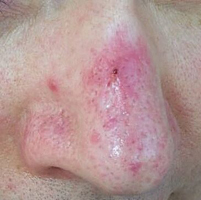 Papules are the inflamed, red, tender bumps with no head. It is highly recommended to Never squeeze papules do to the outcome of scaring.
Papules are the inflamed, red, tender bumps with no head. It is highly recommended to Never squeeze papules do to the outcome of scaring. 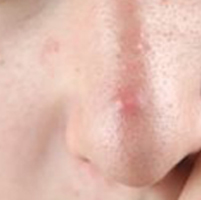 Pustules are inflamed and show up as a red circle with a white or yellow center. Pustules are your garden variety zit.
Pustules are inflamed and show up as a red circle with a white or yellow center. Pustules are your garden variety zit.
 As unlike the information on lesions noted above, nodular acne is spots of acne which can be much larger, quite painful and can last for several months. Nodules are large, hard bumps under the skin’s surface and scarring is quite common with this type of acne. Untreated nodules can sometimes leave an impaction behind, allowing it to flare time and time again. The worst thing you can do if this occurs is to squeeze it. You most likely will cause severe damage to the skin as the lesion may last for months longer than it normally should. It is recommended that treatment be sought from a dermatologist where they can administer a shot of cortisone to reduce any inflammation as well as the chance of scarring.
As unlike the information on lesions noted above, nodular acne is spots of acne which can be much larger, quite painful and can last for several months. Nodules are large, hard bumps under the skin’s surface and scarring is quite common with this type of acne. Untreated nodules can sometimes leave an impaction behind, allowing it to flare time and time again. The worst thing you can do if this occurs is to squeeze it. You most likely will cause severe damage to the skin as the lesion may last for months longer than it normally should. It is recommended that treatment be sought from a dermatologist where they can administer a shot of cortisone to reduce any inflammation as well as the chance of scarring. An acne cyst appears almost similar to a nodule but is pus-filled, and is explained as having a diameter of 5mm or more across. Again they are quite painful and scarring is commonly known to happen with cystic acne. Squeezing an acne cyst will only worsen the situation and cause the infection to spread as it deepens; more painful inflammation which will last much longer than if you had left it alone. Dermatologists usually have ways to reduce swelling and take preventative measures to reduce the chances of scarring scarring, such as administering a cortisone shot.
An acne cyst appears almost similar to a nodule but is pus-filled, and is explained as having a diameter of 5mm or more across. Again they are quite painful and scarring is commonly known to happen with cystic acne. Squeezing an acne cyst will only worsen the situation and cause the infection to spread as it deepens; more painful inflammation which will last much longer than if you had left it alone. Dermatologists usually have ways to reduce swelling and take preventative measures to reduce the chances of scarring scarring, such as administering a cortisone shot. is commonly mistaken for Acne Vulgaris do to the similarity in features. Rosacea appears in the form of a reddish rash and is usually limited to the chin, cheeks, nose and forehead and it affects millions. Rosacea typically affects those who are over the age of 30. The redness is often accompanied by bumps, pimples and skin blemishes. In some cases vessels of blood become more visible through the skin. Rosacea and blackheads are not likely to be found on the same person. It more commonly found in females yet often more severe when found in males. This condition left untreated could cause swelling of the nose along with excessive growth tissue, a condition called Rhinophyma. The treatment for Rosacea is usually different than for acne, Therefore if you suspect your experiencing this condition, contact your dermatologist right away.
is commonly mistaken for Acne Vulgaris do to the similarity in features. Rosacea appears in the form of a reddish rash and is usually limited to the chin, cheeks, nose and forehead and it affects millions. Rosacea typically affects those who are over the age of 30. The redness is often accompanied by bumps, pimples and skin blemishes. In some cases vessels of blood become more visible through the skin. Rosacea and blackheads are not likely to be found on the same person. It more commonly found in females yet often more severe when found in males. This condition left untreated could cause swelling of the nose along with excessive growth tissue, a condition called Rhinophyma. The treatment for Rosacea is usually different than for acne, Therefore if you suspect your experiencing this condition, contact your dermatologist right away. The most severe type of Acne Vulgaris and is most commonly found in males. It is characterized by numerous large lesions, which are sometimes interconnected, along with widespread blackheads. It can cause severe, irreversible damage to the skin, and disfiguring scarring. This unfortunate type of acne is found from your thighs up “Thighs, buttocks back, chest and face.” Acne Conglobata can show up as early as 18 and usually no later than 30, however this condition can stay active for several years after. As with all forms of acne, the cause of Acne Conglobata is unknown. Treatment usually includes
The most severe type of Acne Vulgaris and is most commonly found in males. It is characterized by numerous large lesions, which are sometimes interconnected, along with widespread blackheads. It can cause severe, irreversible damage to the skin, and disfiguring scarring. This unfortunate type of acne is found from your thighs up “Thighs, buttocks back, chest and face.” Acne Conglobata can show up as early as 18 and usually no later than 30, however this condition can stay active for several years after. As with all forms of acne, the cause of Acne Conglobata is unknown. Treatment usually includes  This condition is a bacterial infection characterized by pustules and cysts, possibly occurring as a complication resulting from a long term antibiotic treatment of Acne Vulgaris. It is a rare condition, and we do not know if it is more common in males or females at this time. Fortunately,
This condition is a bacterial infection characterized by pustules and cysts, possibly occurring as a complication resulting from a long term antibiotic treatment of Acne Vulgaris. It is a rare condition, and we do not know if it is more common in males or females at this time. Fortunately,  This type of severe facial acne affects only females, usually between the ages of 20 to 40 years old, and is characterized by large painful nodules, pustules and sores, all of which may scar. It begins abruptly, and may occur on the skin of a woman who has never had acne before. It is confined to the face, and usually does not last longer than one year, but can wreak havoc in a very short time. Doctors often prescribe
This type of severe facial acne affects only females, usually between the ages of 20 to 40 years old, and is characterized by large painful nodules, pustules and sores, all of which may scar. It begins abruptly, and may occur on the skin of a woman who has never had acne before. It is confined to the face, and usually does not last longer than one year, but can wreak havoc in a very short time. Doctors often prescribe 













Pings on Types of Pimples
Comments on Types of Pimples
We will be addressing Rosacea. I am sorry but the website is newer and we made acne vulgaris our first priority.